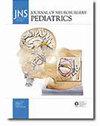Comparative analysis of sport-related concussion: how do 8- to 12-year-old athletes differ from 13- to 17-year-old athletes?
IF 2.1
3区 医学
Q3 CLINICAL NEUROLOGY
引用次数: 0
Abstract
OBJECTIVE Despite the growing literature on sport-related concussion (SRC) in high school and collegiate athletes, the understanding of how outcomes can vary in child athletes younger than 12 years of age remains limited. Therefore, the authors sought to compare injury characteristics and recovery in 8- to 12-year-old athletes with those of 13- to 17-year-old athletes following SRC. METHODS A single-institution retrospective cohort study was undertaken including 8- to 12-year-old and 13- to 17-year-old athletes seen at a regional SRC between November 2017 and January 2022. Demographic information, injury characteristics, Post-Concussion Symptom Scale (PCSS) scores, and recovery (i.e., return to learn [RTL], symptom resolution, and return to play [RTP]) were compared between 8- to 12-year-old and 13- to 17-year-old athletes using the Mann-Whitney U-test and chi-square test. RESULTS A total of 147 athletes (8- to 12-year-old athletes: n = 49; 13- to 17-year-old athletes: n = 98) were included. The mean ages for the younger and older groups were 10.9 ± 0.9 and 15.7 ± 1.3 years, respectively. Athletes aged 8-12 years and 13-17 years had similar median times to initial healthcare presentation (1 vs 2 days, p = 0.37). Athletes aged 8-12 years were more likely to present to the emergency department (ED) (44.9% vs 25.5%, p = 0.02) and receive head imaging (36.7% vs 19.4%, p = 0.02). Initial PCSS scores were similar between the groups (21.5 vs 22.0, p = 0.99). Athletes aged 8-12 years took longer to RTL (median 6.0 [IQR 4.0-13.0] days vs median 4.0 [IQR 2.0-8.0] days, p = 0.04). However, time to symptom resolution (median 16.0 [IQR 7.0-42.0] days vs median 13.5 [IQR 6.3-22.5] days, p = 0.34) and RTP (median 22.5 [IQR 10.0-54.8] days vs median 15.0 [IQR 10.0-24.0] days, p = 0.17) were not significantly different. CONCLUSIONS Comparing 8- to 12-year-old with 13- to 17-year-old concussed athletes, the authors found that the initial PCSS score did not differ, although the younger group was more likely to present to the ED and receive head imaging. The 8- to 12-year-old athletes took more time to RTL, although no differences were found in time to symptom resolution or RTP.运动相关脑震荡的比较分析:8 至 12 岁运动员与 13 至 17 岁运动员有何不同?
目的尽管有关高中生和大学生运动员运动相关脑震荡(SRC)的文献越来越多,但人们对 12 岁以下儿童运动员脑震荡后果的了解仍然有限。因此,作者试图比较8至12岁运动员与13至17岁运动员在脑震荡后的损伤特征和恢复情况。研究方法2017年11月至2022年1月期间,在一家地区脑震荡中心就诊的8至12岁和13至17岁运动员被纳入了这项单一机构回顾性队列研究。采用曼-惠特尼U检验和卡方检验比较了8至12岁和13至17岁运动员的人口统计学信息、受伤特征、脑震荡后症状量表(PCSS)评分和恢复情况(即恢复学习[RTL]、症状缓解和恢复比赛[RTP])。结果共纳入147名运动员(8至12岁运动员:n = 49;13至17岁运动员:n = 98)。低龄组和高龄组的平均年龄分别为(10.9 ± 0.9)岁和(15.7 ± 1.3)岁。8-12 岁和 13-17 岁运动员初次就医的中位时间相似(1 天 vs 2 天,p = 0.37)。8-12 岁的运动员更有可能到急诊科(ED)就诊(44.9% 对 25.5%,p = 0.02)和接受头部成像检查(36.7% 对 19.4%,p = 0.02)。两组的 PCSS 初始评分相似(21.5 vs 22.0,p = 0.99)。年龄在 8-12 岁之间的运动员需要更长的时间来恢复运动能力(中位数 6.0 [IQR 4.0-13.0] 天 vs 中位数 4.0 [IQR 2.0-8.0] 天,p = 0.04)。然而,症状缓解时间(中位数 16.0 [IQR 7.0-42.0] 天 vs 中位数 13.5 [IQR 6.3-22.5] 天,p = 0.34)和 RTP(中位数 22.5 [IQR 10.0-54.8] 天 vs 中位数 15.0 [IQR 10.0-24.0] 天,p = 0.17)没有显著差异。结论作者将 8 至 12 岁的脑震荡运动员与 13 至 17 岁的脑震荡运动员进行比较后发现,虽然年龄较小的运动员更有可能到急诊室就诊并接受头部成像检查,但他们的 PCSS 初始评分并无差异。8 到 12 岁的运动员需要更多的时间来进行 RTL,但在症状缓解时间或 RTP 方面没有发现差异。
本文章由计算机程序翻译,如有差异,请以英文原文为准。
求助全文
约1分钟内获得全文
求助全文
来源期刊

Journal of neurosurgery. Pediatrics
医学-临床神经学
CiteScore
3.40
自引率
10.50%
发文量
307
审稿时长
2 months
期刊介绍:
Information not localiced
 求助内容:
求助内容: 应助结果提醒方式:
应助结果提醒方式:


